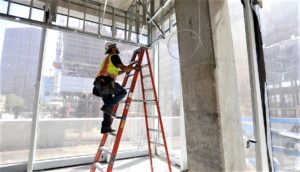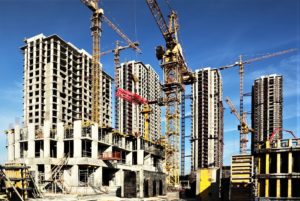On 15th August 2008, the United States Federal Emergency Management Agency (FEMA), in association with the U.S. Department of Homeland Security (DHS) Office for Civil Rights & Civil Liberties, published Comprehensive Preparedness Guide #301: ‘Interim Emergency Management Planning Guide for Special Needs Populations’.
What follows are important extracts from CPG #301. As you slowly read along … consider the chaotic, clapped-out and ramshackle response, at national level, to the Flood Emergency in Ireland …
Throughout the history of Emergency Management Planning, considerations for Special Needs Populations have often been inadequate. From the 1930’s, when disaster response was ad hoc and largely focused on the repair of damaged infrastructure, through to the present day, emergency management culture of ‘readiness’, special needs populations were often given insufficient consideration. This fact was evident in 2003 during the California wildfires and when Hurricane Katrina devastated the Gulf Coast in 2005. During these events, some individuals with special needs did not receive appropriate warning, were unable to access shelters, or went without medical intervention. During the 2006 Nationwide Plan Review, a sample of emergency management plans was reviewed by subject-matter experts on disability and ageing. The review confirmed that emergency plans from various regions in the United States continue to overlook these populations. The Nationwide Plan Review Phase 2 Report concluded that “substantial improvement is necessary to integrate people with disabilities into emergency planning and readiness”.
Numerous ‘lessons learned’ reports that followed Hurricane Katrina also pointed out that there is a large segment of the U.S. population who may not be able to successfully plan for, and respond to, an emergency with resources typically accessible to the general population. The current general population is one that is diverse, ageing, and focused on maintaining independence as long as possible. The popularity of living situations that provide an ‘as needed’ level of care in the least restrictive manner is fast becoming the norm. Consideration should therefore be given to people who may be able to function independently under normal situations, but who may need assistance in an emergency situation.
For example, it is estimated that about 13 million individuals aged 50 years or older in the United States will need evacuation assistance, and about half of these individuals will require such assistance from someone outside of their household. There are well over 1 million people in the United States receiving home healthcare according to 2000 data cited by the National Center for Health Care Statistics. Populations such as these should be considered when emergency plans are developed to accurately assess the resources needed to adequately respond when a disaster strikes. The 2000 Census reported that 18% of those surveyed speak a language other than English at home. This highlights the need to ensure the effectiveness of emergency communications. Populations described as ‘transportation disadvantaged’ – those who do not have access to a personal vehicle or are precluded from driving – may also require assistance during emergencies. The 2000 Census reports that in the top ten car-less cities, between 29% and 56% of the households are without a vehicle. These examples serve to demonstrate community emergency planning should go beyond traditional considerations.
During the Nationwide Plan Review, Emergency Managers consistently requested technical assistance in identifying and incorporating special needs populations into emergency planning. As described later, defining the term ‘special needs’ is a critical initial step in the planning process. The Federal Government introduced, within the National Response Framework (NRF), a definition of special needs populations that State, Territorial, Tribal, and Local governments may adopt for use in their Emergency Operation Plan (EOP) development. It is important to note that though this terminology may appear ambiguous, it is well established in the Emergency Management Vocabulary and when clearly defined, strengthens the planning process.
Although it is recognized that significant emergency planning should be done for incarcerated populations, these groups cannot be integrated into general population planning. Individuals in correctional settings are institutionalized to protect other members of society; people who are institutionalized in health related settings are there for their own protection and wellbeing. Emergency management planning for incarcerated populations requires additional consideration such as law enforcement and co-ordination between emergency managers, the Department of Corrections, and prison superintendents to ensure safety of the prisoners and the public. For these reasons, incarcerated populations are not included in the NRF definition of ‘special needs’, which is the same definition used in this Planning Guide.
U.S. Federal Emergency Management Agency (FEMA) CPG #301
Date: 15 August 2008. PDF File, 301kb.
Interim Emergency Management Planning Guide for Special Needs Populations
Click the link above to read and/or download CPG #301
Emergency Management takes into consideration planning for the safety of every person in the community during and following a disaster. Taking into consideration populations historically considered ‘vulnerable’, ‘at risk’, or ‘special needs’, ultimately improves the overall community’s post-disaster sustainability.
Before drafting Emergency Plans, it is recommended that a state-wide definition for the term ‘special needs’ be developed and used to guide State, Territorial, Tribal, and Local jurisdictions in the planning process. A consistent use of terminology will result in improved communication and co-ordination of resources across State, Territorial, Tribal, and Local entities.
The NRF Definition for ‘special needs’ provides a function-based approach for planning and seeks to establish a flexible framework that addresses a broad set of common function-based needs, irrespective of specific diagnosis, statuses, or labels (e.g. children, older people, transportation disadvantaged, etc.). In other words, this function-based definition reflects the capabilities of the individual, not the condition or label. Governments that choose to align their language to the NRF definition will improve inter-government communication during an incident.
The Definition of Special Needs Populations, as it appears in the U.S. National Response Framework (NRF) is as follows:
Populations whose members may have additional needs before, during, and after an incident in functional areas, including but not limited to:
– Maintaining Independence ;
– Communication ;
– Transportation ;
– Supervision ;
– Medical Care.
Individuals in need of additional response assistance may include those who have disabilities; who live in institutionalized settings; who are elderly; who are children; who are from diverse cultures; who have limited English proficiency; or who are non-English speaking; or who are transportation disadvantaged.
[The concept of a function-based approach to defining special needs populations has been developed by June Isaacson Kailes. See Kailes, J. and Enders, A. in “Moving Beyond ‘Special Needs’: A Function-Based Framework for Emergency Management Planning”. Journal of Disability Policy Studies, Vol./No. 44/2007. Pages 230-237.]
At first glance, it may appear that each of the above groups (and a disproportionately large percentage of the population) is automatically classified as having special needs, but this is not the case. The definition indicates these groups may often include individuals who have special needs and, in the event of an emergency, may need additional assistance or specialized resources. For example, in a city like New York where less than half of all households own a car, transportation-dependence is not necessarily a ‘special need’. A special need in this instance is an inability to access the transportation alternatives defined by the Emergency Operation Plan (EOP). It is important to remember that special needs populations have needs that extend beyond those of the general population.
The definition focuses on the following function-based aspects:
- Maintaining Independence – Individuals requiring support to be independent in daily activities may lose this support during an emergency or a disaster. Such support may include consumable medical supplies (baby diapers, formula, bandages, continence supplies, etc.), durable medical equipment (wheelchairs, walkers, scooters, etc.), service animals, and/or attendants or caregivers. Supplying needed support to these individuals will enable them to maintain their pre-disaster level of independence.
- Communication – Individuals who have limitations which interfere with the receipt of and response to information will need that information provided in format they can understand and use. They may not be able to hear verbal announcements, see directional signs, or understand how to get assistance due to hearing, vision, speech, cognitive, or intellectual limitations, and/or limited English proficiency.
- Transportation – Individuals who cannot drive or who do not have a vehicle may require transportation support for successful evacuation. This support may include accessible vehicles (e.g., lift-equipped or vehicles suitable for transporting individuals who use oxygen) or information about how and where to access mass transportation during an evacuation.
- Supervision – Before, during, and after an emergency individuals may lose the support of caregivers, family, or friends or may be unable to cope in a new environment (particularly if they have dementia, Alzheimer’s or psychiatric conditions such as schizophrenia or intense anxiety). If separated from their caregivers, young children may be unable to identify themselves; and when in danger, they may lack the cognitive ability to assess the situation and react appropriately.
- Medical Care – Individuals who are not self-sufficient or who do not have adequate support from caregivers, family, or friends may need assistance with: managing unstable, terminal or contagious conditions which require observation and ongoing treatment; managing intravenous therapy, tube feeding, and vital signs; receiving dialysis, oxygen, and suction administration; managing wounds; and operating power-dependent equipment to sustain life. These individuals require support of trained medical professionals.
The above examples illustrate function-based needs that may exist within the community.
Important Conclusions for Ireland & Europe Generally:
1. The innovative approach taken to Special Needs Populations in U.S. FEMA Comprehensive Preparedness Guide #301 is entirely consistent with European concepts of ‘mainstreaming’, ‘accessibility for all’, ‘fire safety, protection and evacuation for all’, etc … and the widespread, standardized and consistent use of the language and terminology in the 2001 World Health Organization (WHO) International Classification of Functioning, Disability & Health (ICF) … an approach which I have long advocated across Europe.
2. Fragmentation of the Irish Special Needs Population, dissention between different groups within that population or a lack of willingness to work with other groups … the use of far too many ad-hoc labels … and the anarchic abuse of disability-related language and terminology … pose a grave risk to the Safety, Health and Wellbeing of all these groups in Emergencies, whether large or small scale … and create unnecessary, and sometimes insurmountable, barriers to effective communication and the proper co-ordination of emergency response resources. This problem is deep-rooted and endemic throughout Europe.
3. French use of the words, e.g. ‘les handicapés’, ‘les invalides’, is both outdated and barbaric. Similarly, German use of the word ‘die behinderten’ is unacceptable. A concerted effort, at European level, must be made to modernize and harmonize the use of disability-related terminology in our many different languages. Large Scale Emergencies in Europe, involving 2, 3 or more E.U. Member States, require … as a priority … effective communication and the proper co-ordination of emergency response resources.
END


